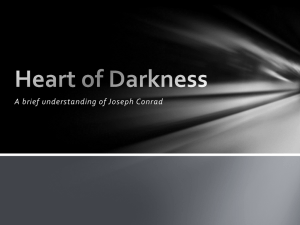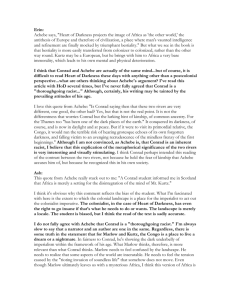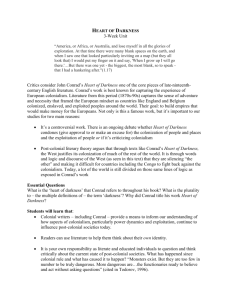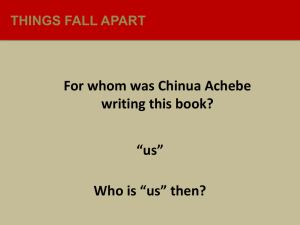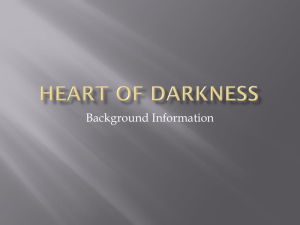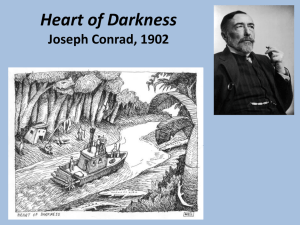Presentation by Elizabeth Villanueva – 28 January 2014 A Summary
advertisement
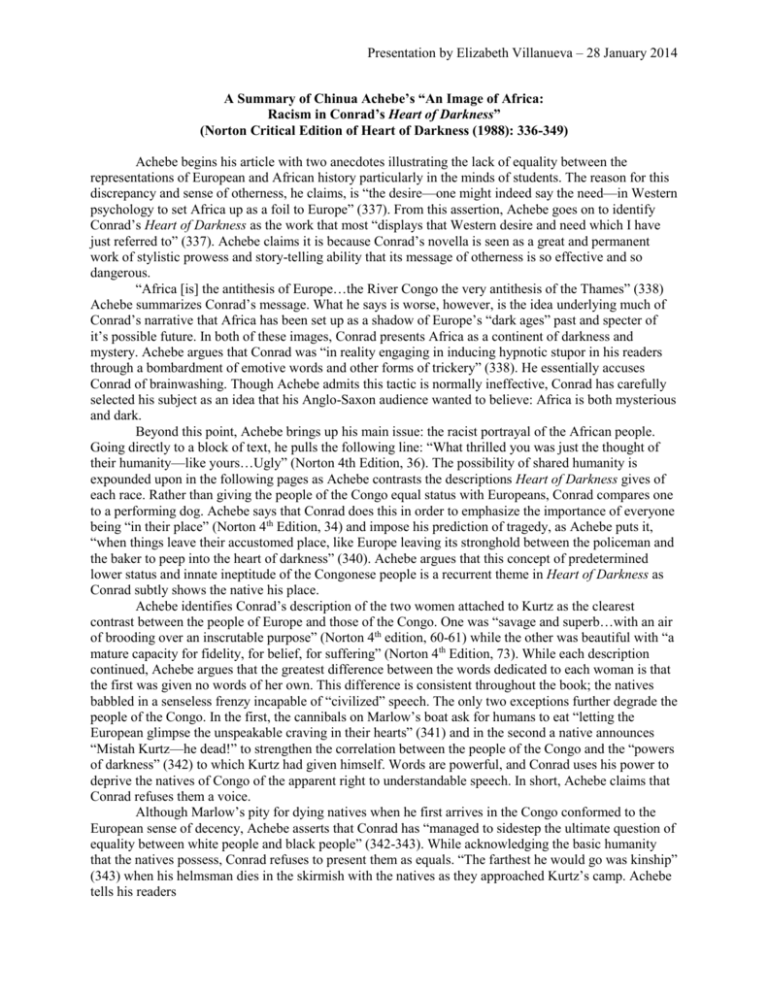
Presentation by Elizabeth Villanueva – 28 January 2014 A Summary of Chinua Achebe’s “An Image of Africa: Racism in Conrad’s Heart of Darkness” (Norton Critical Edition of Heart of Darkness (1988): 336-349) Achebe begins his article with two anecdotes illustrating the lack of equality between the representations of European and African history particularly in the minds of students. The reason for this discrepancy and sense of otherness, he claims, is “the desire—one might indeed say the need—in Western psychology to set Africa up as a foil to Europe” (337). From this assertion, Achebe goes on to identify Conrad’s Heart of Darkness as the work that most “displays that Western desire and need which I have just referred to” (337). Achebe claims it is because Conrad’s novella is seen as a great and permanent work of stylistic prowess and story-telling ability that its message of otherness is so effective and so dangerous. “Africa [is] the antithesis of Europe…the River Congo the very antithesis of the Thames” (338) Achebe summarizes Conrad’s message. What he says is worse, however, is the idea underlying much of Conrad’s narrative that Africa has been set up as a shadow of Europe’s “dark ages” past and specter of it’s possible future. In both of these images, Conrad presents Africa as a continent of darkness and mystery. Achebe argues that Conrad was “in reality engaging in inducing hypnotic stupor in his readers through a bombardment of emotive words and other forms of trickery” (338). He essentially accuses Conrad of brainwashing. Though Achebe admits this tactic is normally ineffective, Conrad has carefully selected his subject as an idea that his Anglo-Saxon audience wanted to believe: Africa is both mysterious and dark. Beyond this point, Achebe brings up his main issue: the racist portrayal of the African people. Going directly to a block of text, he pulls the following line: “What thrilled you was just the thought of their humanity—like yours…Ugly” (Norton 4th Edition, 36). The possibility of shared humanity is expounded upon in the following pages as Achebe contrasts the descriptions Heart of Darkness gives of each race. Rather than giving the people of the Congo equal status with Europeans, Conrad compares one to a performing dog. Achebe says that Conrad does this in order to emphasize the importance of everyone being “in their place” (Norton 4th Edition, 34) and impose his prediction of tragedy, as Achebe puts it, “when things leave their accustomed place, like Europe leaving its stronghold between the policeman and the baker to peep into the heart of darkness” (340). Achebe argues that this concept of predetermined lower status and innate ineptitude of the Congonese people is a recurrent theme in Heart of Darkness as Conrad subtly shows the native his place. Achebe identifies Conrad’s description of the two women attached to Kurtz as the clearest contrast between the people of Europe and those of the Congo. One was “savage and superb…with an air of brooding over an inscrutable purpose” (Norton 4th edition, 60-61) while the other was beautiful with “a mature capacity for fidelity, for belief, for suffering” (Norton 4th Edition, 73). While each description continued, Achebe argues that the greatest difference between the words dedicated to each woman is that the first was given no words of her own. This difference is consistent throughout the book; the natives babbled in a senseless frenzy incapable of “civilized” speech. The only two exceptions further degrade the people of the Congo. In the first, the cannibals on Marlow’s boat ask for humans to eat “letting the European glimpse the unspeakable craving in their hearts” (341) and in the second a native announces “Mistah Kurtz—he dead!” to strengthen the correlation between the people of the Congo and the “powers of darkness” (342) to which Kurtz had given himself. Words are powerful, and Conrad uses his power to deprive the natives of Congo of the apparent right to understandable speech. In short, Achebe claims that Conrad refuses them a voice. Although Marlow’s pity for dying natives when he first arrives in the Congo conformed to the European sense of decency, Achebe asserts that Conrad has “managed to sidestep the ultimate question of equality between white people and black people” (342-343). While acknowledging the basic humanity that the natives possess, Conrad refuses to present them as equals. “The farthest he would go was kinship” (343) when his helmsman dies in the skirmish with the natives as they approached Kurtz’s camp. Achebe tells his readers Presentation by Elizabeth Villanueva – 28 January 2014 It is important to note that Conrad, careful as ever about his words, is concerned not so much about distant kinship as about someone laying claim on it. The black man lays a claim on the white man which is well-nigh intolerable. It is the laying of this claim which frightens and at the same time fascinates Conrad. (343) Though the word “kinship” at first inspires belief in Marlow’s commitment to the bond of humanity, closer inspection of the passage shows that Conrad merely deigns to acknowledge the native’s claim without confirming him as an equal. Achebe summarizes his textual points with the statement, “The point of my observations should be quite clear by now, namely that Joseph Conrad was a thoroughgoing racist” (343). Though Africa can be read in the novella as simply as a carrier for Kurtz’s breakdown, the fact that an entire continent can be reduced to a literary device illustrates a deeper problem that Achebe identifies in the European mindset. Conrad validates and strengthens this mindset by masking his racist assertions with eloquence. This racist attitude, Achebe continues, is clear from Conrad’s reflective writings which Achebe describes as “irrational love [of white] and irrational hate [of black] jostling together in the heart of that talented, tormented man” (345). Though Conrad is dead, Achebe takes a stance against him because his influence lingers in what is “today perhaps the most commonly prescribed novel in twentieth-century literature courses in English Departments of American universities” (346). Achebe responds to the potential refutations that a) fiction is not written to please its subjects and b) Conrad had personal experience in the Congo by claiming that it is likely that Conrad intentionally overlooked positive aspects of African culture. Achebe provides the example of the masterful art of the Fang People that brought “the infusion of new life into European art, which had completely run out of strength” (347) around 1905. From this example, Achebe shows that Conrad’s portrayal of the African people as a whole is shown as inadequate. Achebe expounds on this thought two paragraphs later, however, by relieving Conrad of some of the blame for his mindset when he says “it was and is the dominant image of Africa in Western imagination” (348). Though Achebe makes a fiery case for the racism in Heart of Darkness and in the Western mindset as a whole, he concludes his essay Although the work of redressing which needs to be done may appear too daunting, I believe it is not one day too soon to begin. Conrad saw and condemned the evil of imperial exploitation but was strangely unaware of the racism on which it sharpened its iron tooth. But the victims of racist slander who for centuries have had to live with the inhumanity it makes them heir to have always known better that any casual visitor even when he comes loaded with the gifts of a Conrad. (349) Essentially, Achebe is asserting that his essay is merely bringing to light the deeply rooted issue of European racism that the African people have both been aware of and suffered as a result of for centuries. Additional Recommended Readings: Fleming, Bruce. "Brothers Under The Skin: Achebe On Heart Of Darkness." College Literature 19/20.3/1 (1992): 90. Academic Search Complete. Web. 26 Jan. 2014. Galton, Francis. “The Comparative Worth of Different Races.” Heart of Darkness: an authoritative text, background, and contexts, criticism 4th ed. (A Norton Critical Edition). Paul B. Armstrong, ed. New York, NY: W.W. Norton & Company, Inc., 2006: 224-229. Print Hawkins, Hunt. “Heart of Darkness and Racism.” Heart of Darkness: an authoritative text, background, and contexts, criticism 4th ed. (A Norton Critical Edition). Paul B. Armstrong, ed. New York, NY: W.W. Norton & Company, Inc., 2006: 365-375. Print James, A., and M. Johnson. "Victorian Anthropology, Racism, And `Heart Of Darkness'." Ariel 28.4 (1997): 111. Academic Search Complete. Web. 26 Jan. 2014. Lees, Lynn Hollen. "Being British In Malaya, 1890-1940." Journal Of British Studies 48.1 (2009): 76101. Academic Search Complete. Web. 26 Jan. 2014. Phillips, Caryl, and Chinua Achebe. "Was Joseph Conrad Really A Racist?." Philosophia Africana 10.1 (2007): 59-66. Academic Search Complete. Web. 26 Jan. 2014.
